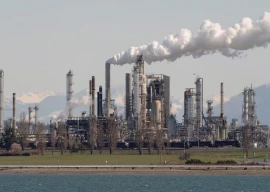
At global climate conferences, where critical decisions about our future are made, adaptation struggles to secure a place in the spotlight. Instead, it often lingers in the shadows as a stepchild to the more dominant player — mitigation. This is unfortunate for countries like Pakistan that are ill-equipped to execute necessary adaptation programmes due to scarce financing and inadequate institutional capacity, along with competition between other necessary developmental needs.
Despite pressing adaptation needs, a significant chunk of available funds is channelled into mitigation. For instance, between 2019 and 2020, around $571 billion targeted mitigation, whereas adaptation received just $50 billion. The UN asserts that developing countries currently require $70 billion annually for adaptation — a figure that could swell to $140-$300 billion by 2030 and escalate further to $280-$500 billion by 2050.
However, the stark reality is that countries that are most vulnerable to climate change receive less than $1 per person for adapting to or preparing for disasters. Illustratively, Pakistan requires a staggering $348 billion, equivalent to 10.7% of its cumulative GDP, to climate-proof itself from 2023 to 2030. Out of this, $152 billion is exclusively designated for adaptation efforts. The government has introduced the National Adaptation Plan (NAP), along with initiatives like the Living Indus Initiative to enhance the country’s resilience but the resource and capacity gap is massive, and Pakistan needs to explore innovative mechanisms domestically to close this gap.
One way to bridge this gap is by involving the private and the business sector through policy incentives. Agriculture sector is the backbone of our economy, but it’s extremely vulnerable to climate impacts. While some industry players are taking steps to reduce their carbon footprint, mainly to remain competitive in the global market, there remains a significant need for intensified efforts in terms of adaptation across the entire supply chain. Research by PwC and the WEF underlines that adapting to climate change isn’t just an environmental concern; it’s a business imperative to prevent economic losses due to climate impacts. It can open new revenue streams, achieve cost savings, ensure long-term sustainability and safeguard the very communities and ecosystems where businesses operate. It’s a matter of prioritising the long term over the allure of short-term gains. Businesses can no longer employ the “end justifies the means” approach. In this scenario, the “end” quite literally signifies the end of the road and if businesses fail to adapt, there will be no future to anticipate.
Another challenge with adaptation is the narrative around it. Often, policymakers label it as “costly” or “expensive”, yet they neglect to emphasise its benefits. World Bank highlights that investing in resilient infrastructure in low- and middle-income countries could yield an average net benefit of $4.2 trillion, translating to a remarkable $4 in benefit for every $1 invested. The Global Commission on Adaptation highlights that investing $1.8 trillion into adaptation across five crucial areas from 2020 to 2030 could yield a staggering $7.1 trillion in total benefits. These target areas encompass early warning systems, climate-resilient infrastructure, enhanced dryland agriculture crop production, global mangrove protection and projects aimed at bolstering the resilience of water resources. The private sector must focus on these areas in light of NAP to secure their future sustainably.
The COP28 Presidency has a major task in their hands — adaptation must deliver on reducing poverty and inequality which can be done through even distribution of climate finance and a framework for a proactive role by the private sector in enhancing resilience. Investing in marginalised communities and low-income areas not only aligns with business logic but also enhances long-term resilience. The narrative we weave around adaptation is pivotal — one that reframes adaptation not as a story of sacrifice and deprivation, but as an account of opportunity and advancement. It’s a narrative where lives flourish, health prospers and well-being thrives.
Published in The Express Tribune, September 12th, 2023.
Like Opinion & Editorial on Facebook, follow @ETOpEd on Twitter to receive all updates on all our daily pieces.















COMMENTS
Comments are moderated and generally will be posted if they are on-topic and not abusive.
For more information, please see our Comments FAQ